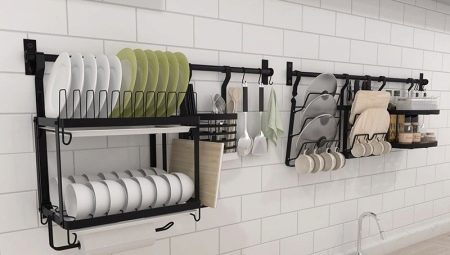When planning the interior of the kitchen, you should correctly place all the necessary accessories. This also applies to the dryer for dishes, because it is needed not only for drying, but also for storing kitchen utensils. Considering all sorts of options, it is important not to miss outboard models. They are in no way inferior to the traditional arrangement in the kitchen cabinet and have a lot of advantages.

Features
Under the hinge should be understood a dryer that can be mounted on a wall or any other suitable vertical surface. Moreover, such a kitchen accessory can be attached directly to the wall, the bottom of the upper cabinet or hung on special devices - roof rails. It all depends on the weight of the product, the location and the wall, which should not only be suitable for fastenings, but also able to withstand a long load.

Hinged dryers have a lot of positive features that distinguish them from other types (built-in or tabletop). Among the advantages, the following factors can be noted.
- Reasonable expenditure of time and effort. In an open dryer, the dishes dry quickly without wiping. Furthermore, drying is also suitable for storage.
- Ease of use - no need to perform many manipulations.
- Save space. The interior and surface of the countertops remain free for storage and cooking.
- The possibility of fixing in any convenient place (most often in the immediate vicinity of the sink). The railing mounts are also convenient in that they can be easily moved and swapped.
- A wide range, allowing you to choose the option that meets your requirements - strength, reliability, affordability.
- Ease of installation and subsequent care.
- Use as a decoration for the kitchen interior.
The complaints are mainly related to hygiene, since the drying remains open and dust or splashes can get on the dishes stored in it. It is not scary if you mark it correctly and take care of timely cleansing.

Dimensions
Since the wall dryer is not limited to the interior space of the furniture or the surface of the countertop, its dimensions can be absolutely any. You can find very modest specimens with a width of 25 cm, which can be placed almost anywhere. But there are also wide shelves (80-90 cm), the placement of which should be agreed with other items. In this case, outlets, pipes, gas stove and other objects should not interfere. And wall mounts should be reliable enough for such a load.
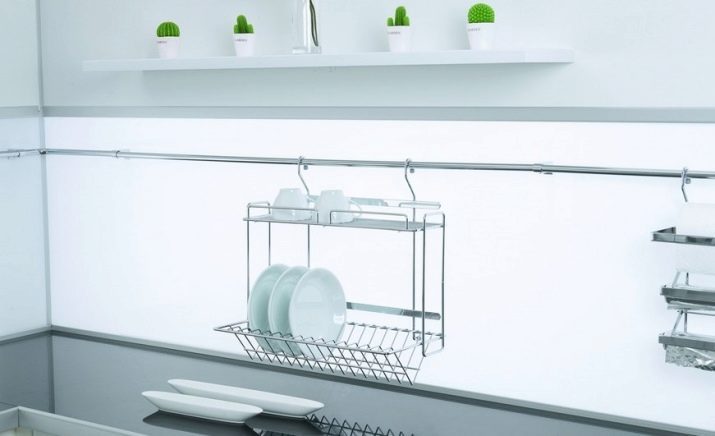
The most popular sizes of hanging dryers are 50 and 60 cm. This size is enough for an average family. In addition, they look commensurate with the standard dimensions of other kitchen furniture and appliances - because in the interior, symmetry and harmony are important in everything. For accessories that are hung on rails, and not screwed directly to the wall, a slightly smaller shelf width is used - within 45 cm.
The distance between the levels in the dryer should be sufficient for free installation and removal of dishes.
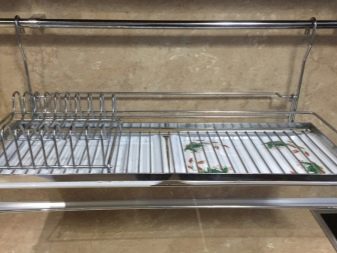

The dimensions of the dryer must match its position among the furniture. As a rule, it is placed on the working wall - directly above the sink for washing dishes. A slight shift to the right is allowed, but so that you do not have to take several steps with each washed item. Dishes should easily fit on the upper level - for example, so that the upper hanging cupboards do not interfere with this. For plates, this distance should be at least 25 cm, for glasses enough 15-20 cm.
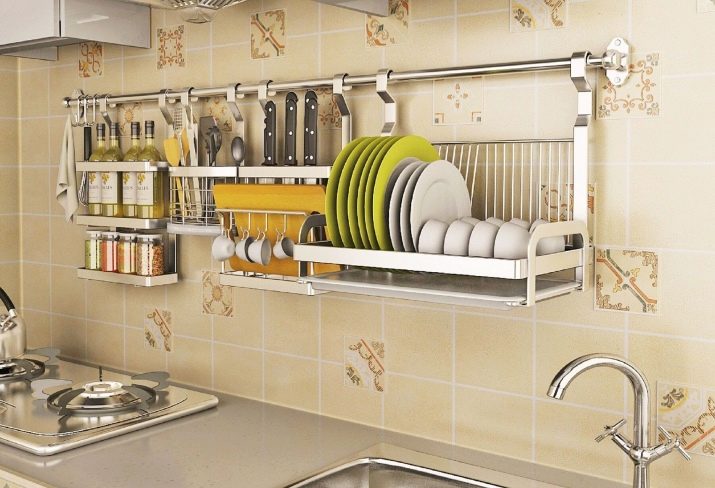
The distance from the sink, if it is located directly under the dryer, should be sufficient so that it does not reach the spray and is not limited to hand movements. The design should not interfere with work, since cooking often requires quite a lot of activity.
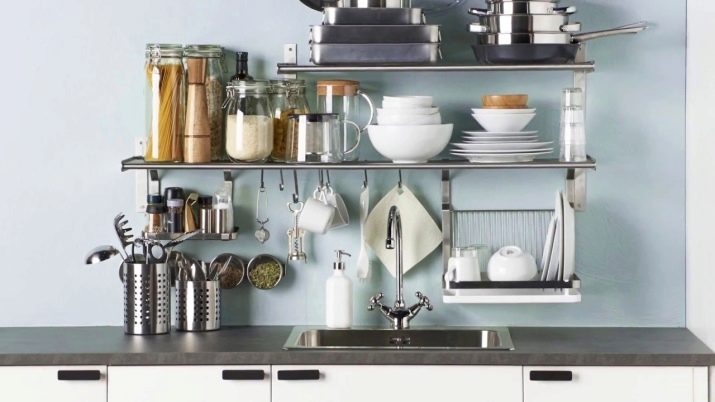
Kinds
Most often in dryers there are compartments for plates (with a ribbed surface) and glasses (an even lattice shelf). Some models have additional compartments for cutlery and other kitchen utensils. Among the accessories for railing, you can find both combined options and those designed only for one type of cookware - for example, with holders for glasses or a glass for knives and forks.

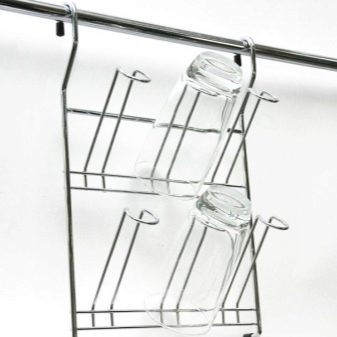
All mounted dryers differ in the number of levels.
- The surface of models with one level usually combines different types of holders.
- Two-level more spacious. As a rule, the upper level is intended for cups and glasses, and the lower - for other items.
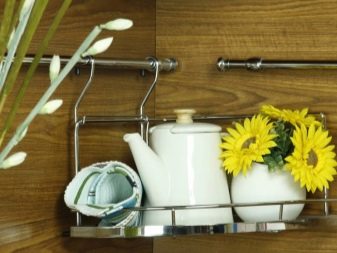
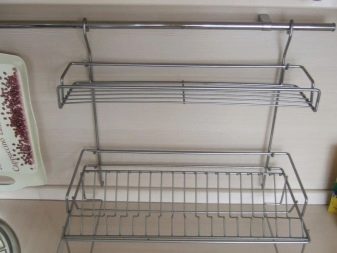
In addition to the device, dryers are different and depending on the material of manufacture.
- Metal. The most common option for dryers, as it is considered more reliable and durable. It is preferable to purchase a stainless steel product - it is strong enough and not subject to corrosion. There are many metal dryers with various coatings, but for the most part they are inferior to stainless steel - they can rust and bend. To maintain the style of the interior, you can find products made of brushed metal, enameled, in bronze.
- Wooden. Such material is easily processed, differs in external beauty, can be decorated with carvings and patterns. Over time, excess moisture can deform. Therefore, it is better to store dry dishes here or replace the grate with metal, leaving only the case wooden. Most often, such items are used more to decorate the interior, especially if the style in which it is designed requires it.
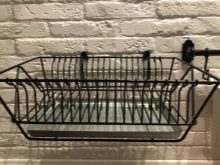
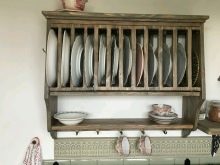
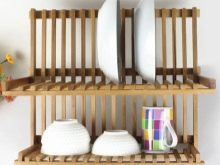
Plastic is used only for the manufacture of individual parts (for example, an external casing, a pallet).Plastic parts can be transparent or colored, which adds to their appeal. But in terms of strength, plastic will always be inferior to metal, especially when it comes to joints and fixtures.
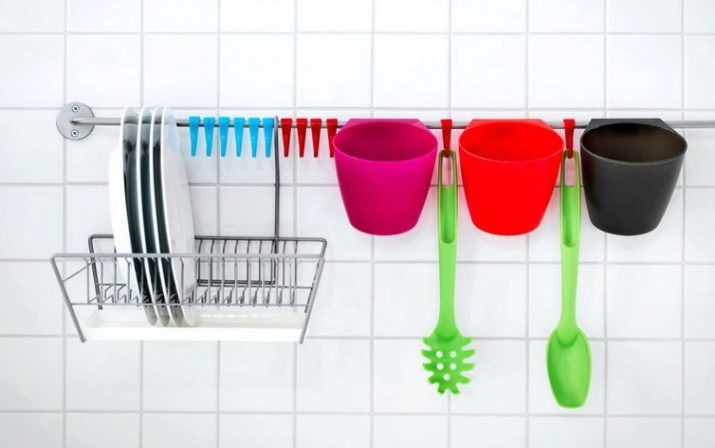
How to choose?
When choosing a mounted dryer several factors must be considered at once.
- The size. Drying should contain as many dishes as necessary, and at the same time fit in the designated place. Small drying is only suitable as a temporary container, from which the dishes will have to be transferred to the cupboard all the time. A large, and even two-level, not everywhere can be marked. Therefore, you need to pre-estimate the number of dishes and measure suitable lengths on the wall.
- The material of manufacture. First of all, it is necessary to evaluate its practicality, and only then its appearance. Since the drying will be in a conspicuous place, the material should allow to maintain its appearance in a presentable condition. Any frame, especially brilliant, will often have to be polished, to erase traces of water and dust.
- Mounting option. If in addition to the dryer you need all kinds of holders and shelves, you can install a railing system that will look holistic. Drying screwed to the wall will be more difficult to remove and even more so transfer to another place. However, in the case of railing, you need to correctly calculate the load.
- Filling. Not every dryer can put all the available dishes. The main thing here is to calculate not only the number of kitchen utensils, but also their size. Even for large cookware, lids, wine glasses and other items that usually do not fit in a conventional dryer, there are options.
It is worth making sure that both ordinary plates and cups are fixed in the dryer well, do not hang out, do not fall. Optimally, if drying has a retractable tray, which can be easily washed and put back.
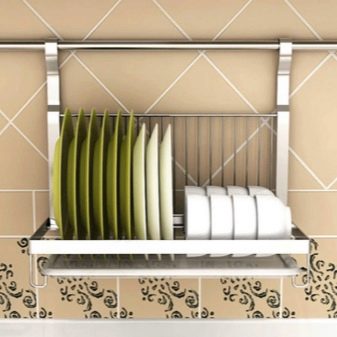
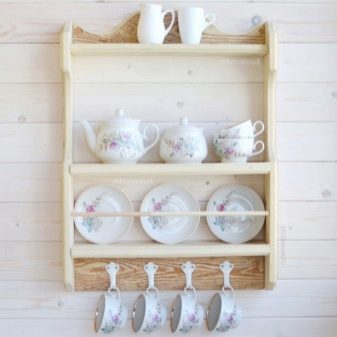
Different models of dryers will differ from each other in their filling and convenience. Of course, small nuances will be revealed only in practice, so you should get acquainted with the reviews in advance and evaluate the experience of other people.
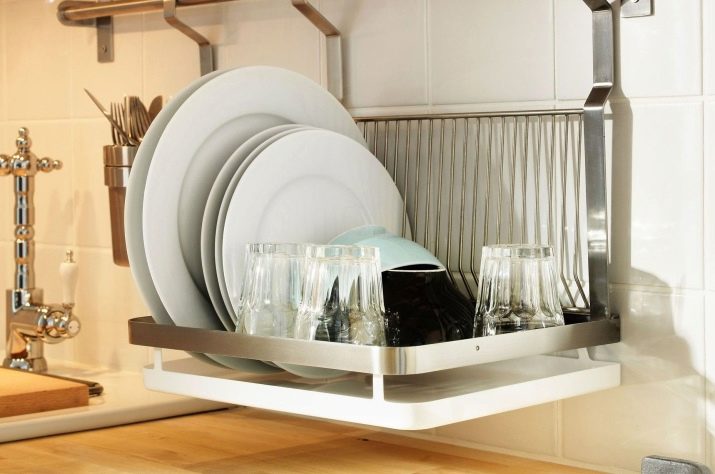
In this video you will learn how to make an original dish dryer from old linen hangers.
